scale bar= 1cm
Sedges - native and introduced. (Cyperaceae)


Sedges make up a large family. Most, but not all, are found in swampy, wet or damp locations. A typical flower consists of a single modified leaf (the glume) that covers the seed [see illustration right]. The seed may be absent (an infertile flower), or there may also be anthers (bisexual flower), or there may be anthers only (a male flower), or the bract may be empty. None of the sedges have showy petals. There may be many flowers arranged along a common stalk (a spikelet) and there may be many spikelets (illustration far right). In a few sedges, the seed is contained in a bottle-like bag.
Forest plants with leafy tussocks Flower clusters cylindrical, stems hollow
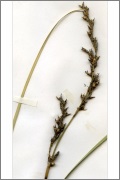 Variable Sword-sedge (Lepidosperma laterale) Flower stalks flat. Flowers scattered. Common.
Variable Sword-sedge (Lepidosperma laterale) Flower stalks flat. Flowers scattered. Common.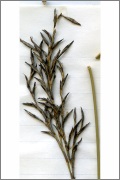 Wire Rapier-sedge (Lepidosperma semiteres) Flower stalks roundish with angles or with a flat edge. Flowers scattered. Stalks often flexuose. Scattered.
Wire Rapier-sedge (Lepidosperma semiteres) Flower stalks roundish with angles or with a flat edge. Flowers scattered. Stalks often flexuose. Scattered. 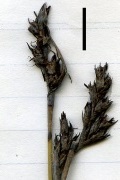 Variable Sword-sedge (Lepidosperma curtisiae) Flower stalks rounded, erect. Flowers few, clustered. Scattered.
Variable Sword-sedge (Lepidosperma curtisiae) Flower stalks rounded, erect. Flowers few, clustered. Scattered.  Thatch Saw-sedge (Gahnia radula) Wet forest flats. Dark flower clusters. Leafy to 2m.
Thatch Saw-sedge (Gahnia radula) Wet forest flats. Dark flower clusters. Leafy to 2m. 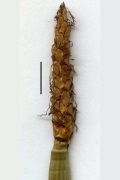 Tall Spike-rush (Eleocharis sphacelata). Stems wide (5mm or more), in water. 1m-2m high.
Tall Spike-rush (Eleocharis sphacelata). Stems wide (5mm or more), in water. 1m-2m high.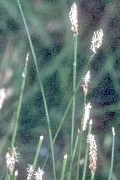 Common Spike-rush (Eleocharis acuta) Stems less than 3mm wide, less than 50cm high. Mud flats. Common.
Common Spike-rush (Eleocharis acuta) Stems less than 3mm wide, less than 50cm high. Mud flats. Common.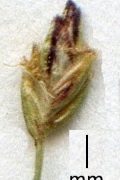 Small Spike-rush (*Eleocharis pusilla) Stems narrow (0.5mm), to 15mm high, flower custers egg-shaped. Uncommon.
Small Spike-rush (*Eleocharis pusilla) Stems narrow (0.5mm), to 15mm high, flower custers egg-shaped. Uncommon.Tall, leafy sedges. Flowers in single terminal cylindrical clusters
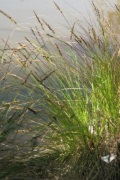 Tall Sedge (Carex appressa) Leafy tussocks with triangular flower stalks 1m or more. Flowers in long terminal clusters. Leaf prickles point upwards. Common.
Tall Sedge (Carex appressa) Leafy tussocks with triangular flower stalks 1m or more. Flowers in long terminal clusters. Leaf prickles point upwards. Common.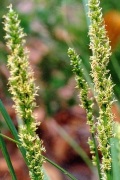 Hillside Sedge (Carex incomitata) Like Tall sedge, but leaf prickles point downwards. Uncommon.
Hillside Sedge (Carex incomitata) Like Tall sedge, but leaf prickles point downwards. Uncommon. 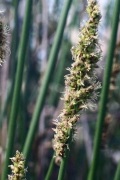 Rush Sedge (Carex tereticaulis) Like Tall Sedge, but flower stalks round, not triangular. Moderately common.
Rush Sedge (Carex tereticaulis) Like Tall Sedge, but flower stalks round, not triangular. Moderately common.Miscellaneous sedges
 Awned Club-rush (*Isolepis hystrix) Small sedge (5cm), flowers spiky looking.
Awned Club-rush (*Isolepis hystrix) Small sedge (5cm), flowers spiky looking. 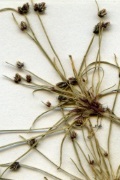 Club-rush (Isolepis marginata) Small sedge c5cm. Glumes arranged spirally. Flowering stalks much exceed the leaves.
Club-rush (Isolepis marginata) Small sedge c5cm. Glumes arranged spirally. Flowering stalks much exceed the leaves. 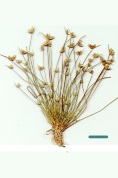 Tiny Flat-sedge (*Isolepis levynsiana) Small tufted sedge. Spikelets in 2s or 3s; flowers arranged oppositely in spikelets, floral bracts longer thn flowers.
Tiny Flat-sedge (*Isolepis levynsiana) Small tufted sedge. Spikelets in 2s or 3s; flowers arranged oppositely in spikelets, floral bracts longer thn flowers. 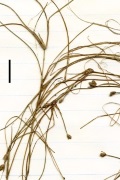 Floating Club-rush (Isolepis fluitans) Submerged sedge, with flower stalks. Weak stems.
Floating Club-rush (Isolepis fluitans) Submerged sedge, with flower stalks. Weak stems.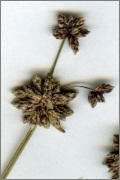 Swamp Club-rush (Isolepis inundata) Slender erect sedge. Flowers clustered into balls, new flower clusters form from original cluster.
Swamp Club-rush (Isolepis inundata) Slender erect sedge. Flowers clustered into balls, new flower clusters form from original cluster. 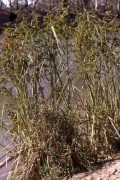 Tall Flat-sedge (Cyperus exaltatus) By streams. Large sedge with very numerous brown flower clusters.
Tall Flat-sedge (Cyperus exaltatus) By streams. Large sedge with very numerous brown flower clusters. 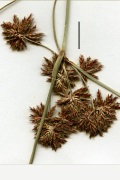 Creeping Flat-sedge (Cyperus lhotskyanus By streams. Medium size (to 1m). Numerous flower clusters.
Creeping Flat-sedge (Cyperus lhotskyanus By streams. Medium size (to 1m). Numerous flower clusters. 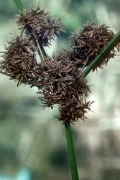 Flecked Flat-sedge (Cyperus gunnii) By streams. Medium size (to 1m). Numerous small flower clusters.
Flecked Flat-sedge (Cyperus gunnii) By streams. Medium size (to 1m). Numerous small flower clusters.  Dark Flat-sedge (Cyperus sanguinolentus) Swampy places. Flower clusters often appear striped.
Dark Flat-sedge (Cyperus sanguinolentus) Swampy places. Flower clusters often appear striped.  Globe Kylinga (Cyperus sphaeroideus) Damp areas. Flower clusters ball-shaped, with slender leafy bracts.
Globe Kylinga (Cyperus sphaeroideus) Damp areas. Flower clusters ball-shaped, with slender leafy bracts.  River Club-rush (Schoenoplectus tabernaemontani) Large rush-like plant. Branched flower stalks with small flower clusters.
River Club-rush (Schoenoplectus tabernaemontani) Large rush-like plant. Branched flower stalks with small flower clusters.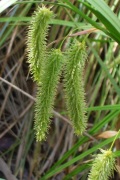 Tassel Sedge (Carex fascicularis) Flowers on slender stalks, drooping. Male and female flowers in separate clusters.
Tassel Sedge (Carex fascicularis) Flowers on slender stalks, drooping. Male and female flowers in separate clusters.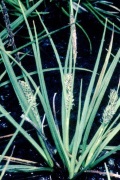 Sedge (Carex gaudichaudiana)Male and female flowers in separate erect clusters, between leaves.
Sedge (Carex gaudichaudiana)Male and female flowers in separate erect clusters, between leaves.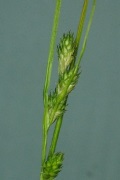 Knob Sedge (Carex inversa) Medium sedge, usually c30cm high. Flowers in terminal clusters, with leafy bracts exceeding the flowers.
Knob Sedge (Carex inversa) Medium sedge, usually c30cm high. Flowers in terminal clusters, with leafy bracts exceeding the flowers.  Divided Sedge (*Carex divisa) Flowers in small terminal clusters. Leafy bracts short. Common.
Divided Sedge (*Carex divisa) Flowers in small terminal clusters. Leafy bracts short. Common. Drain Flat-sedge (*Cyperus eragrostis) Green flowers. Weedy places e.g. drains. Long leafy bracts from flower bases.
Drain Flat-sedge (*Cyperus eragrostis) Green flowers. Weedy places e.g. drains. Long leafy bracts from flower bases.  Soft Twig-rush (Baumea rubignosa) Swards. Rare.
Soft Twig-rush (Baumea rubignosa) Swards. Rare. Common Bog-rush (Schoenus apogon) Small branched leafy plant. Narrow black flowers from between the leaves. Common.
Common Bog-rush (Schoenus apogon) Small branched leafy plant. Narrow black flowers from between the leaves. Common.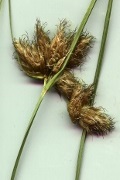 Marsh Bog-rush (Bolboschoenus medianus) Flower clusters have a fuzzy appearance. Uncommon.
Marsh Bog-rush (Bolboschoenus medianus) Flower clusters have a fuzzy appearance. Uncommon..